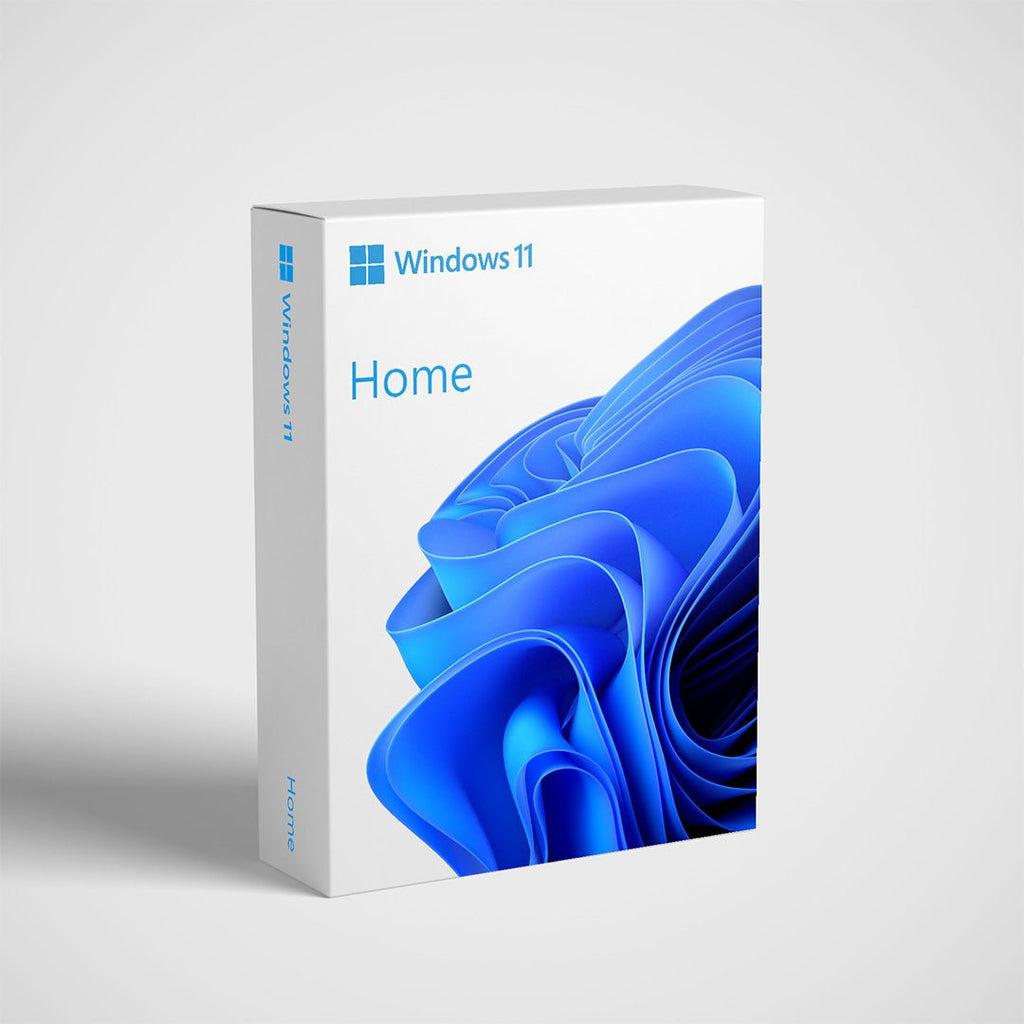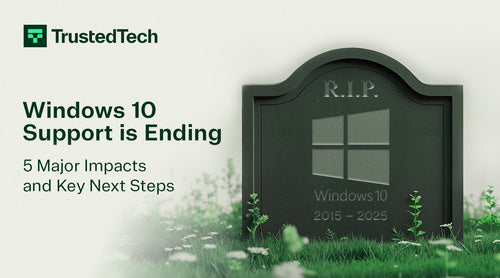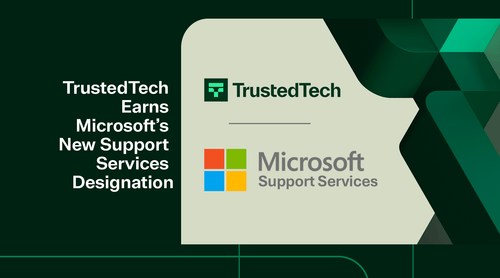Microsoft’s Windows 10 will reach its official end-of-support (EOS) on October 14, 2025. This date which has been set in stone for over a year carries significant ramifications for the millions of individuals and businesses still using the decade-old OS. Below, we break-down the key impacts of Windows 10’s end-of-life, and the options users have moving forward. It’s crucial to understand these changes in order to stay secure, compliant, and productive in a post-Windows 10 world.
End-of-Support Date
Oct 14, 2025
Official end-of-support for Windows 10 (Home/Pro)
Extended Updates
Through 2028
Paid security updates for Windows 10 are available up to 3 years post-EOL

Windows 10 Usage (July 2025)
53% Windows 11 vs 43% Windows 10
Share of PCs still on Windows 10 at 43% vs. Windows 11 at 53%
5 Major Impacts of Windows 10 EOS
When Windows 10’s support period ends, certain guarantees and services that users take for granted will disappear. Continuing to run Windows 10 after October 2025 introduces serious security, stability, and compliance risks. Below are five key impact areas to be aware of once Windows 10 is out of support.
1) Compliance and Regulatory Risks
Running an unsupported OS isn’t just a technical risk; it can become a legal and compliance risk. Many industry regulations and data protection laws (such as HIPAA for healthcare, GDPR in Europe, PCI-DSS for payment systems) require organizations to maintain up-to-date security on systems that handle sensitive data. Using Windows 10 beyond its end-of-support can put companies out of compliance, since the OS will no longer receive patches to address new vulnerabilities. In the event of a data breach or audit, the company could be found negligent for relying on obsolete software, leading to fines or legal penalties. For example, continuing to use unpatched Windows 10 in a healthcare setting could be deemed a violation of HIPAA’s security rule, which might result in severe fines and sanctions. Insurance and contracts may also mandate supported software: as noted, cyber insurance claims might be denied if an outdated OS was a contributing factor. In short, businesses have a lot at stake beyond just IT concerns in retiring Windows 10 on time. The cost of non-compliance or a breach could far exceed the cost of upgrading the OS.
2) No More Security Updates/Patches
The biggest key take-a-way from the EOS announcement is that your OS will be highly vulnerable to cyberattacks. After support ends, Windows 10 will no longer receive security patches or vulnerability fixes. This effectively opens the floodgates to malware, ransomware, and other cyber threats. Attackers often treat end-of-life systems as prime targets, knowing that any security flaws found after October 14, 2025, will remain unpatched, leaving systems exposed. In other words, the day support ends is “open season” for hackers on Windows 10 machines. The lack of updates means that even minor vulnerabilities can accumulate and be chained into major exploits over time. Users will have to rely on third-party security tools (which themselves may drop support eventually) and hope for the best. This situation also has cyber-insurance implications, running unsupported software can void cybersecurity insurance coverage in the event of a breach.
3) No Bug Fixes or Feature Updates
Once Windows 10 has reached its end of support lifespan, Microsoft will no longer address any glitches, bugs, or performance issues that surface. If a part of the OS malfunctions or a software update introduces a bug after October 2025, Microsoft won’t issue a patch to fix it. Any further development of Windows 10 is DOA with no new features, enhancements, or optimizations coming around this product. Over time, this could lead to interoperability and stability problems as other software evolves around an unchanging core OS. For example, if a future driver or application expects an OS update that never came, it may behave unpredictably on Windows 10. Essentially, Windows 10 will remain feature-frozen in 2025 and on while the rest of the software ecosystem moves on.
4) End of Technical Support from Microsoft
Official support channels for Windows 10 will shut down after the EOS date. This means if you encounter an issue, Microsoft’s support team will not assist you beyond perhaps telling you to upgrade your OS. According to a PC World article; Microsoft has stated that if you contact support for Microsoft 365 Apps on an unsupported Windows 10, and the issue “doesn’t occur on Windows 11,” support will simply urge you to move to Windows 11 first. In addition, many third-party software vendors may also refuse to troubleshoot problems on Windows 10 since it’s no longer a supported platform. Users will be essentially on their own for any Windows 10 system problems. Community forums and unofficial workarounds will replace official help desks – an unsettling prospect for businesses used to enterprise support agreements. This lack of support extends to all kinds of issues: from security incidents to compatibility headaches, you won’t be able to call up Microsoft (or likely other vendors) for answers.
5) Reduced Compatibility with New Software & Hardware
As time goes on, new software applications, drivers, and hardware will be designed for newer or SaaS-based iterations of Windows. Software makers typically drop support for older OS versions once they become obsolete. For instance, Microsoft Edge on Windows 10 will continue getting updates only until late 2028 (to align with extended security programs), and Google Chrome is expected to follow a similar timeline. After that, even web browsers which are essential for a secure online experience will stop updating on Windows 10. Many other developers will likewise phase out Windows 10 compatibility over time. This means gradually you may find that new versions of important apps (office suites, design software, security tools, etc.) simply won’t install or run properly on Windows 10. The same goes for hardware: new printers, graphics cards, or peripherals in 2026+ might not have Windows 10 drivers available. Over a couple of years, an unsupported Windows 10 PC could become increasingly isolated: stuck with older versions of software and unable to work with newer tech. This attrition in compatibility will happen gradually but inevitably, making Windows 10 less practical and more frustrating to use with each passing month after support ends.
In particular, graphics support is already on a ticking clock: Nvidia has announced it will continue releasing “Game Ready” GPU drivers for Windows 10 only until October 2026. After that, Nvidia drivers for Windows 10 move to a security-only maintenance mode. Owners of slightly older Nvidia cards (GeForce GTX 900 and 10-series) will see their final driver versions in October 2025, with only quarterly security patches provided through October 2028. No new features or game optimizations will be backported to those drivers beyond 2025. In effect, Windows 10 gamers get a one-year reprieve of full support (through late 2026), but post-2026 even new GPUs won’t get Win10 drivers, you’d need to upgrade to Windows 11 to receive any further driver improvements. This is a prime example of hardware vendors shifting focus: other manufacturers are likely to impose similar cut-offs for Windows 10 support on their devices.

3 Options for Windows 10 Users
After End of Support With Windows 10’s end-of-life on the horizon, users and organizations should take proactive steps. Fortunately, there are a few clear paths forward once support ends. The best option is to get onto a supported platform as soon as possible. However, Microsoft recognizes that immediate transition isn’t feasible for everyone, so they’ve offered some stopgap measures. Here are the main options as Windows 10 sunsets.
1) Upgrade to Windows 11 (Perpetual but Modern, Supported OS)
The most straightforward and strongly recommended path is to upgrade to Windows 11. Windows 11 is the current Microsoft OS (released in 2021) and will continue to be supported for years to come. By moving to Windows 11, you regain a fully supported operating system with regular security updates, bug fixes, and access to new features (including many modern enhancements and security improvements Microsoft has built since Windows 10). Upgrading to Windows 11 is the best way to ensure uninterrupted support and compatibility with new software. It also places you on the front foot for new technologies (like upcoming AI-powered features in Office and Windows).
2) Purchase Extended Security Updates (ESU) – Temporary Lifeline
For organizations unable to fully migrate to Windows 11 by the October 2025 deadline, Microsoft offers Extended Security Updates (ESUs) a paid program providing critical security patches for up to three years. Aimed at businesses with complex environments or legacy dependencies, ESUs allow continued protection on Windows 10 through 2028, with costs increasing annually to encourage timely upgrades. Initial pricing starts around $61 per device for businesses, while consumers can purchase a one-time, one-year extension for about $30, with limited promotional offers available.
Tip: If you opt for Extended Security Updates (ESU), don’t delay deploying them. Treat the ESU period as a grace period to finish migrations. Keep track of ESU expiry (yearly) and budget accordingly if you need year 2 or 3. Also, ensure all systems enrolled in ESU are indeed receiving the patches. This may require certain update configurations or endpoint management to be in place.
Do you have questions or want help enrolling? Contact your TrustedTech Account Manager to receive the best possible rates and ensure everything’s set up correctly.
3) Upgrade Hardware or Migrate to a New Device
Some Windows 10 computers, especially older ones, cannot run Windows 11 due to hardware limitations. Windows 11 requires relatively recent CPUs and enabled security features that many pre-2016 PCs lack. For these machines, upgrading may mean purchasing new hardware. Users with incompatible PCs should start planning for a device refresh. The end of Windows 10 support is coinciding with a broader hardware upgrade cycle; as mentioned, Microsoft and PC manufacturers are touting 2025 as a big refresh year for moving to modern Windows 11 PCs.
If your current PC is not eligible for Windows 11, you effectively have two main options:
- If your PC doesn’t meet Windows 11 requirements, upgrading hardware such as the CPU, motherboard, or adding a TPM module may be possible but is often complex and not cost-effective compared to buying a new device. Replacing the machine with a Windows 11-compatible PC is typically the simpler and more future-proof solution, offering better performance, enhanced security features, and support for upcoming updates.
- For businesses, hardware refreshes can align with regular upgrade cycles or lease renewals, while individuals should assess whether aging devices (especially those 7–10 years old) are worth keeping. Alternatively, users unwilling to move to Windows 11 might consider switching to a different operating system like Linux or macOS, though this is less common. For most, upgrading hardware or transitioning to Windows 11 remains the most practical path forward.
Conclusion: Planning for a Smooth Transition
As Windows 10 approaches its end-of-support date on October 14, 2025, users and organizations must prepare for a future where the operating system becomes increasingly obsolete and insecure. Staying on Windows 10 long-term will lead to diminishing app compatibility, growing compliance and security risks, and mounting inconvenience. While Microsoft offers Extended Security Updates (ESUs) as a temporary safety net, these are costly and limited in scope, providing only critical patches without feature improvements. By 2027, Windows 10 systems will feel outdated and unsupported, much like Windows 7 did in its final years, making proactive planning essential to avoid disruptions.
The transition to Windows 11 is not just a technical upgrade, it’s a strategic move to maintain security, productivity, and compliance. Microsoft has provided clear pathways, including free upgrades for many users and ESUs for those needing more time, but these are stopgap measures, not long-term solutions. Individuals should assess their hardware readiness and plan upgrades or replacements, while businesses must treat this as a major IT initiative, involving inventory, testing, training, and phased deployment. The risks of delay are real: unpatched vulnerabilities, insurance issues, and compatibility breakdowns. By acting now, users can embrace a more secure and modern computing experience, ensuring they’re ready, not scrambling when support ends.
Shop our Windows 11 Products
 |
Details
|
Key Dates and Milestones
To put everything in perspective, here is a timeline of important dates related to Windows 10’s end of support and the surrounding ecosystem changes:
- July 29, 2015: Windows 10 Released - The launch of Windows 10. Microsoft commits to a ~10-year support lifecycle, culminating in its EOL in 2025.
- January 2025: Windows 11 “Refresh Year” - At CES 2025, Microsoft dubs 2025 the “Year of the Windows 11 PC Refresh,” urging users to upgrade hardware/OS.
- April 2025: Office 2016/2019 Alert - Microsoft reminds customers that Office 2016 and Office 2019 support ends on October 14, 2025, alongside Windows 10.
- May 2025: Support Extension Announced - Microsoft announces that Microsoft 365 Apps (Office) will get security updates on Win10 through October 2028, extending support by 3 years. Also confirms Edge browser support on Win10 through 2028.
- July 2025: Extended Security Updates (ESU) Details - Microsoft reveals pricing and terms for Windows 10 ESU: up to 3 years of patches (2025–2028), with escalating costs per year. Individuals offered 1-year extension for $30.
- Oct 14, 2025: Windows 10 End-of-Support - Official end of support for Windows 10. No more free patches or Microsoft support. Office 2016/2019 reaches the end of support on the same date. Start of Year 1 ESU (if purchased).
- Late 2025: Post-EOL Phase Begins - Windows 10 continues running without updates. Users and organizations start relying on ESUs or face increasing security risks.
- August 2026: Feature Freeze on Office Apps - Microsoft 365 apps on Windows 10 enter “feature freeze.” No new features will be delivered to Office on Win10 after this point, only security fixes.
- Oct 13, 2026: Office 2021 Support Ends - End of support for Office 2021 (5 years after release) and Office LTSC 2021. Users are encouraged to move to Office 365 or Office 2024. This roughly marks the end of all actively supported Office versions on Windows 10.
- Oct 2026: Driver Support Winds Down - Nvidia and likely other vendors end full device driver support for Windows 10. Nvidia provides final Game Ready driver in 2025 and stops new feature updates by Oct 2026 (security-only thereafter).
- Oct 14, 2027: Windows 10 ESU Year 2 Ends - For organizations that bought 2nd year of ESU, support expires. Costs significantly higher now if opting for a third year of patches.
- Oct 10, 2028: Windows 10 End-of-Life Final Windows 10 Patch - End of all Extended Security Updates for Windows 10. Last possible security patches issued this month. Also, Microsoft 365 Office apps cease all updates on Windows 10. Even Microsoft Edge stops updating on Win10 at this point. Windows 10 is completely out of support in every aspect.
- Oct 2028: Last Nvidia Security Update - Nvidia’s final security-only driver updates for legacy GPUs on Windows 10 are released (final wrap-up of support for GTX 10-series/900-series). Hardware and software ecosystem fully moves on from Windows 10.
As the timeline shows, the crucial date is Oct 14, 2025, after which the dominoes start falling. By 2028, the Windows 10 era will truly close, with even browsers and extended patches coming to an end. These milestones reinforce why it’s essential to transition well before those final dates.














